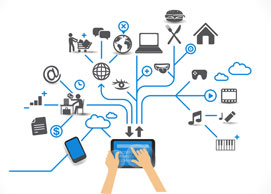
15 Tech and Marketing Trends: 2020 Edition
More than half (55%) of the world’s population has Internet access. That’s 4 billion people. And just about as many use email — a staggering 3.9 billion email users worldwide. Over 3 billion people use social media. That’s pretty impressive if you consider it took about 80 years for Americans to adopt the dishwasher. The Internet got there in less than a decade.
Trend #1: Coronavirus will f*ck everything up, at least for a while
It’s not good. Duh. And you don’t need us to tell you about it. Suffice it to say, every startup, industry, company, person, organization, town is suffering. That’s bad for business, technology, life in general. Goldman Sachs predicts zero earnings growth for US companies this year because of coronavirus.
Trend #2: Politics will be the elephant in the room
USA elections, Europe, Brexit, refugees, China, North Korea… there’s a lot of political uncertainty and change coming. How can markets be so calm even with seemingly ever rising geopolitical uncertainty? We’re not quite sure. We do know companies and organizations will be forced to adapt to distant but potentially disruptive geopolitical shifts. Consider how healthcare changes in the US will impact insurance companies and customers, hospitals, pharma and biotech. Or the ripples of Brexit across finance, real estate and fintech.
Trend #3: Cognitive technologies are coming of age
Cognitive technologies are unlike anything that’s come before. They use natural language processing and machine learning to understand, reason and learn. As a results, smart machines will fuel strategic growth, find answers to complex business questions, transform manufacturing, and put each customer at the very center of every marketing campaign. Cognitive technologies use cognitive insights (data of all types from practically all sources — structured and unstructured) correlate and analyze to inform business decisions. Of course, leadership, smarts and strategy are key: what are the questions and what business decisions can be impacted.
Trend #4: The (customer) journey is more important than the type of passenger
Customer journey mapping will become a more important business tool than audience segmentation. Rarely is there a single linear customer journey; more usually customer journeys are pretzel-shaped. Look for more attention paid to customer experience (CX) and user models. as mapping the journey will soon outweigh the gains from segmentation. Sure there are customer journey implementation challenges, but benefits ware enormous.
Trend #5: More, better apps
There are over 4 million apps available on Android and Apple app stores. There will be more apps, and they’re going to change the way we live and do business. Also look for apps backed by more powerful data, more cognitive technologies, AR and VR apps, apps designed for wearable devices, IoT and mobile payments, and apps integrated with chatbots,
Trend #6: Better, faster access to data
As databases and software engineers close the loop on integrating databases and creating, flatter, more fungible data pools, we will be able unify data sources, which means better, faster access to data. At the same time, big data and big databases will contribute to the data gains more than simply data gulch.
Trend #7: Shift from mobile strategy to engagement strategy
Mobile is not an island, demographic or state of mind. Mobile devices are just a vehicle — a pretty dominant one — we use to communicate, shop, learn, share, etc. The path to digital transformation means an engagement strategy that will includes better positioning for the customer who happens to be on a mobile device and ways of evaluating and integrating hardware (wearable devices) and software (new mobile apps) into customer journey.

Trend #8: AI is here, kind of
You’ve probably had some interaction with AI, and there is more, much more, on the horizon. Conversational UIs (like Amazon Echo), chatbots, and cobots (collaborative machines that work alongside humans) are already here. AI has the potential to introduce new sources of business growth and change how work is done. Spending on AI and machine learning will grow from $12B in 2017 to $57.6B by 2021. (And there’s a bit of confusion about AI versus machine learning). According to an Accenture study, AI could double economic growth rates by 2035, and increase labor productivity by up to 40%. Advances in AI (conversation, context, machine learning) will mean a sea change in the way we interact with computers. Of course, increased productivity is not the holy grail as it may take jobs away (as many as eight hundred million jobs by 2030, some warn) and move gains from people to companies. Bill Gates warns of the danger of “(crossing) the threshold of job replacement of certain activities all at once.” That’s why Gates believes AI and robots should be taxed and monitored.
Trend #9: AR and VR will continue to grow
In the past year, augmented reality (AR) and virtual reality (VR) have quietly become, well, a reality. We’ve seen Facebook, Sony, Nintendo, Samsung and many others launch VR games and devices, and VR has been making a splash in film and TV, as well as art around the world. TechCrunch reports AR could become the primary driver of a $108 billion VR/AR market by 2021, with AR taking the lion’s share of $83 billion and VR $25 billion. It’s a nascent industry, folks, and that means growing pains will be right there alongside growth. But it’s an industry with wings, AR and VR may change a lot of industries, generating billions of dollars, from healthcare to real estate to retail to the military.
Trend #10: IoT (internet of things)
Smart refrigerators, appliances, cars and lightswitches are already here. The internet of things is taking shape. There are still a lot of roadblocks ahead, like system architecture and standards, but the smarter future has already started. Management guru Michael Porter says IoT will be the “Third Wave of IT-Driven Competition” that will “unleash another leap in productivity.” Gartner predicts that the number of connected devices will grow from 8.4 billion in 2017 to 21 billion in 2020. GE, which has staked its future growth on the Industrial Internet, as it refers to the new landscape of connected devices and machinery, estimates this market will add between $10 and $15 trillion to the global GDP within 20 years.
Trend #11: Cool new stuff in email
Email still outperforms. With a median ROI of 122%—more than four times higher than social media, direct mail and paid search—email is still top of the marketing game. There’s a lot of excitement and cool new stuff in email. Look for more interactive email, better email personalization and automation. We’ll also be seeing more marketers focusing not just at newsletters and official emails but at employee’s individual email accounts (and, for example, updating sigs and interstitial content in salespeoples’s emails). In 2019, we will look for more real-time communications in email, more video, personalization, AI, more automation and integration (Zembula, Zapier, Persado are some platforms that will help marketers build smarter, better email programs).
Trend #12: Getting away from the channel focused mindset
With mobile an established part of the communications landscape and marketing landscape, brands will look beyond the channel: what works best for what experience and what each customer needs in the relevant channel, time, tone, etc. Brands want saliency in a cluttered landscape; customers want it all—a top notch user experience in realtime, on any device.
Trend #13: Smart data trumps big data
Yeah, yeah, big data is going to be the next big thing for a long time now. But we think in the short term, there’s more gold to be mined from smart data—machine learning, integrating multiple data sources in real time, and new strategies based on culling data. For marketers this means learning how to gather these new data and pinpoint opportunities.
Trend #14: Security
Still going… The cost of data breaches is going up. Did you know the time to identify a breach is 197 days, while the time to contain a breach is 69 days? In 2016, a staggering 1.4 billion data records were breached (an increase of 86% over the previous year). 2017 saw a whole lot of data breaches. Equifax, Verizon, Bell Canada, Yahoo and Uber to name a few. And in 2018 Facebook and Starwood Hotels made news with data breaches that potentially exposed data of hundreds of millions of users. (Who hasn’t stayed in a Marriott or other Starwood Hotel?). And it’s a huge story, in part because the hackers were not a bunch of criminal nerds who wanted to buy stuff but, according to the New York Times, Chinese hackers whose aim was to build a map of who’s who in America. Plus there’s ransomware and a whole lot of records exposed. According to one study, hackers stole or compromised an estimated $27BN worth of records from businesses in 2017. Is your data safe? We rely more and more on online data, use more online services, while cyber criminals get smarter and more audacious every year. Billions of consumer records are compromised and millions of dollars stolen every year. It’s no wonder cybersecurity is projected to grow to $170 billion by 2020.
> Read our take on Cybersecurity: The Good, The Bad, The Hacked
Trend #15: China
China has more than 800 million Internet users and 98% of them are mobile users. China boasts the largest middle class in the world and the biggest e-commerce market. In Beijing and Shanghai, 90% of residents shop online. Meanwhile, only 10% of the population have passports. Currently, China is home to nine of the world’s 20 biggest internet companies by market cap while the U.S. has 11. Five years ago, China had two and the U.S. had nine. The authoritarian-capitalist model is thriving, and China is on track to surpass U.S. GDP by 2029. Meanwhile, it’s also home to human rights abuses, censorship, and a lot of state-funded hacking (see no. 14, above).
•••
What trends do you think will transform your industry? What are the opportunities for your business or organization? Let us know.


